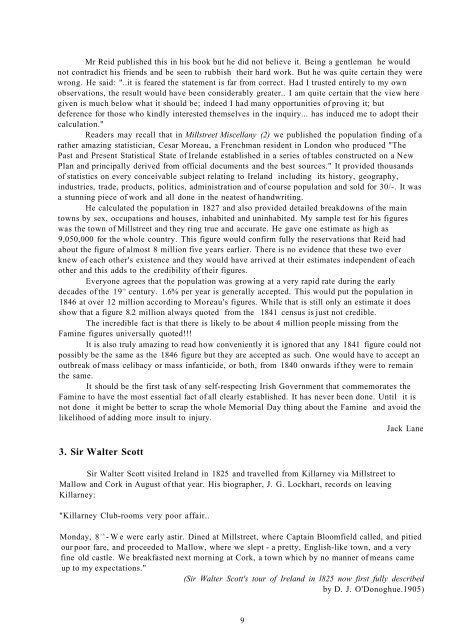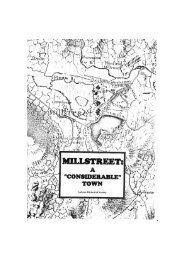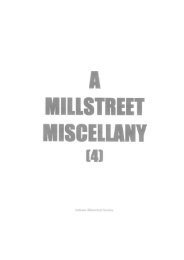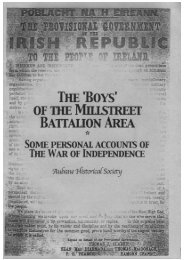A Millstreet Miscellany (3) - Aubane Historical Society
A Millstreet Miscellany (3) - Aubane Historical Society
A Millstreet Miscellany (3) - Aubane Historical Society
You also want an ePaper? Increase the reach of your titles
YUMPU automatically turns print PDFs into web optimized ePapers that Google loves.
Mr Reid published this in his book but he did not believe it. Being a gentleman he would<br />
not contradict his friends and be seen to rubbish their hard work. But he was quite certain they were<br />
wrong. He said: "..it is feared the statement is far from correct. Had I trusted entirely to my own<br />
observations, the result would have been considerably greater.. I am quite certain that the view here<br />
given is much below what it should be; indeed I had many opportunities of proving it; but<br />
deference for those who kindly interested themselves in the inquiry... has induced me to adopt their<br />
calculation."<br />
Readers may recall that in <strong>Millstreet</strong> <strong>Miscellany</strong> (2) we published the population finding of a<br />
rather amazing statistician, Cesar Moreau, a Frenchman resident in London who produced "The<br />
Past and Present Statistical State of Irelande established in a series of tables constructed on a New<br />
Plan and principally derived from official documents and the best sources." It provided thousands<br />
of statistics on every conceivable subject relating to Ireland including its history, geography,<br />
industries, trade, products, politics, administration and of course population and sold for 30/-. It was<br />
a stunning piece of work and all done in the neatest of handwriting.<br />
He calculated the population in 1827 and also provided detailed breakdowns of the main<br />
towns by sex, occupations and houses, inhabited and uninhabited. My sample test for his figures<br />
was the town of <strong>Millstreet</strong> and they ring true and accurate. He gave one estimate as high as<br />
9,050,000 for the whole country. This figure would confirm fully the reservations that Reid had<br />
about the figure of almost 8 million five years earlier. There is no evidence that these two ever<br />
knew of each other's existence and they would have arrived at their estimates independent of each<br />
other and this adds to the credibility of their figures.<br />
Everyone agrees that the population was growing at a very rapid rate during the early<br />
decades of the 19 th<br />
century. 1.6% per year is generally accepted. This would put the population in<br />
1846 at over 12 million according to Moreau's figures. While that is still only an estimate it does<br />
show that a figure 8.2 million always quoted from the 1841 census is just not credible.<br />
The incredible fact is that there is likely to be about 4 million people missing from the<br />
Famine figures universally quoted!!!<br />
It is also truly amazing to read how conveniently it is ignored that any 1841 figure could not<br />
possibly be the same as the 1846 figure but they are accepted as such. One would have to accept an<br />
outbreak of mass celibacy or mass infanticide, or both, from 1840 onwards if they were to remain<br />
the same.<br />
It should be the first task of any self-respecting Irish Government that commemorates the<br />
Famine to have the most essential fact of all clearly established. It has never been done. Until it is<br />
not done it might be better to scrap the whole Memorial Day thing about the Famine and avoid the<br />
likelihood of adding more insult to injury.<br />
Jack Lane<br />
3. Sir Walter Scott<br />
Sir Walter Scott visited Ireland in 1825 and travelled from Killarney via <strong>Millstreet</strong> to<br />
Mallow and Cork in August of that year. His biographer, J. G. Lockhart, records on leaving<br />
Killarney:<br />
"Killarney Club-rooms very poor affair..<br />
t h<br />
Monday, 8 -We were early astir. Dined at <strong>Millstreet</strong>, where Captain Bloomfield called, and pitied<br />
our poor fare, and proceeded to Mallow, where we slept - a pretty, English-like town, and a very<br />
fine old castle. We breakfasted next morning at Cork, a town which by no manner of means came<br />
up to my expectations."<br />
(Sir Walter Scott's tour of Ireland in l825 now first fully described<br />
by D. J. O'Donoghue.1905)<br />
9





